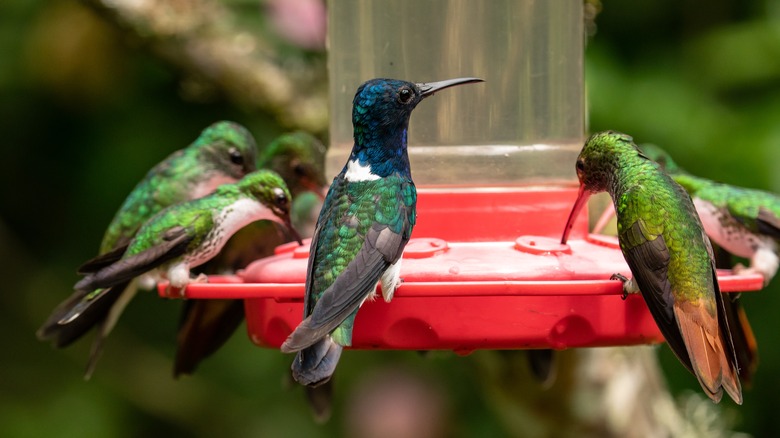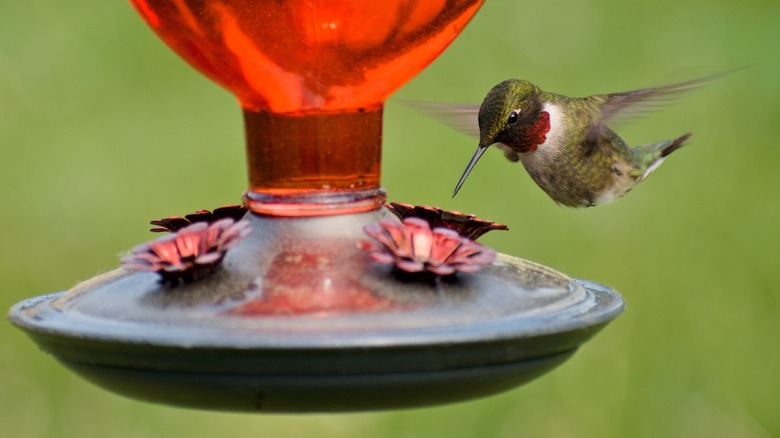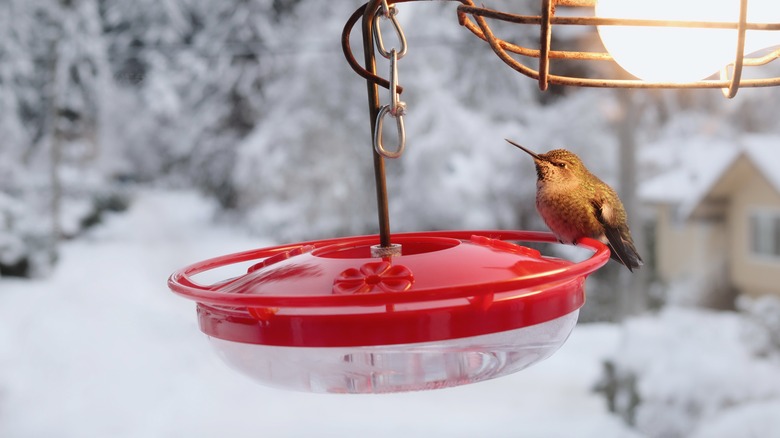Homemade Hummingbird Nectar Is Surprisingly Easy To Make
It's easy to make nectar that hummingbirds love to drink with a simple mixture of sugar and water, and there are many reasons why they need this extra source of hydration. Beating their wings around 53 times per second, their quick movements are supported by a high metabolism that needs nourishment (via the National Park Service). A hummingbird can eat enough nectar and insects to equal 50% of its body weight each day. During nesting season, this diet may include up to 2,000 small bugs daily, returning often to the nest to feed the young birds, per Cornell University. In addition, they may double their weight to prepare for winter migration. All of this activity can be dehydrating, which is why additional sources of hummingbird food are critical.
Providing this nectar is worthwhile in other ways as well. According to Growing Produce, one farmer used hummingbird feeders on his blackberry farm in place of more toxic pest control methods, setting up 25 feeders per acre. The air became filled with the small birds as they hunted insects, entertaining the workers by pausing to rest on their arms and hats. Because so many insects were consumed around the growing plants, the farm avoided spraying the crops with pesticides. This wonderful result was made possible by attracting the birds with a simple sugar mixture in each feeder. If you want to draw hummingbirds to your yard, follow this recipe to create the homemade nectar they love.
Recipe for nectar
Create the mixture by combining 1 cup of spring water with ¼ cup of white granulated sugar, per The International Hummingbird Society. It's absolutely essential to use only pure white sugar that has been refined because this process removes any remnants of molasses, which contains iron that is harmful to the birds. Other types of sugar can be toxic as well, including honey, which will start to breed dangerous bacteria and fungi when it's mixed with water. Artificial sweeteners shouldn't be used because they don't offer the nutrients that regular table sugar provides.
Spring water is best because it doesn't need to be boiled, just stirred vigorously to help dissolve the sugar. However, boiling the water can help dissolve the sugar more quickly, as long as the mixture is thoroughly cooled before adding it to the feeder. Tap water is generally fine to use, but it's recommended to boil tap water to remove any chemicals and to prevent mold and yeast from developing in the mixture. It's also recommended to boil the water if you plan to store extra in the refrigerator for several days. However, the best solution is to make small batches at a time to keep the nectar fresh.
Tips for feeding hummingbirds
Replace the food and wash the feeder approximately every 2 to 3 days, per Cornell University. Warm weather can make the nectar spoil quickly and even become contaminated once birds begin to drink from the feeder. Because mold is dangerous for hummingbirds, it's best to wash the feeder each time you refill it. Never add fresh nectar to what's left inside from the last feeding. On cold or rainy days, you can increase the amount of sugar to ⅓ cup mixed with 1 cup of water. The extra sugar will give the hummingbirds more energy on these chillier days. In addition, several small feeders are better than one large one, as hummingbirds are naturally very protective and territorial.
Finally, an important tip is to leave the feeder up for several weeks past the initial chill of fall, even if you haven't had visitors in a while. The beginning of migration often coincides with the first frost, making nectar harder to find for any birds that start to migrate later than others. Your feeder might be just the source of energy they need to begin their expedition south.
Seeing a hummingbird is always a special moment, like catching a glimpse of a tiny fairy that alights on a flower and then disappears. Providing a feeder filled with homemade nectar will be a delight for both you and your hummingbird visitors.



